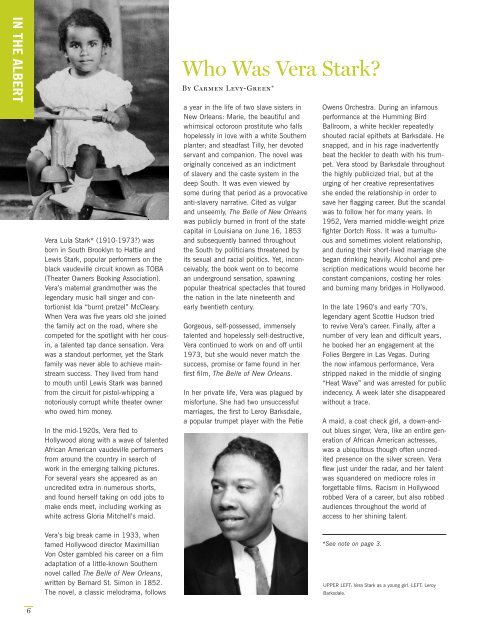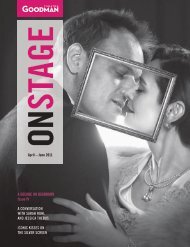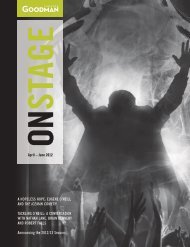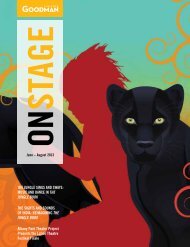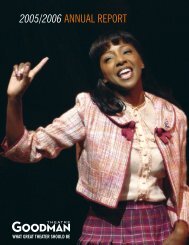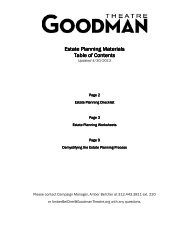BEYOND VERA STARK: HOLLYWOOD'S ... - Goodman Theatre
BEYOND VERA STARK: HOLLYWOOD'S ... - Goodman Theatre
BEYOND VERA STARK: HOLLYWOOD'S ... - Goodman Theatre
You also want an ePaper? Increase the reach of your titles
YUMPU automatically turns print PDFs into web optimized ePapers that Google loves.
IN THE ALBERT<br />
Vera Lula Stark* (1910-1973?) was<br />
born in South Brooklyn to Hattie and<br />
Lewis Stark, popular performers on the<br />
black vaudeville circuit known as TOBA<br />
(Theater Owners Booking Association).<br />
Vera’s maternal grandmother was the<br />
legendary music hall singer and contortionist<br />
Ida “burnt pretzel” McCleary.<br />
When Vera was five years old she joined<br />
the family act on the road, where she<br />
competed for the spotlight with her cousin,<br />
a talented tap dance sensation. Vera<br />
was a standout performer, yet the Stark<br />
family was never able to achieve mainstream<br />
success. They lived from hand<br />
to mouth until Lewis Stark was banned<br />
from the circuit for pistol-whipping a<br />
notoriously corrupt white theater owner<br />
who owed him money.<br />
In the mid-1920s, Vera fled to<br />
Hollywood along with a wave of talented<br />
African American vaudeville performers<br />
from around the country in search of<br />
work in the emerging talking pictures.<br />
For several years she appeared as an<br />
uncredited extra in numerous shorts,<br />
and found herself taking on odd jobs to<br />
make ends meet, including working as<br />
white actress Gloria Mitchell’s maid.<br />
Who Was Vera Stark?<br />
By Carmen Levy-Green*<br />
a year in the life of two slave sisters in<br />
New Orleans: Marie, the beautiful and<br />
whimsical octoroon prostitute who falls<br />
hopelessly in love with a white Southern<br />
planter; and steadfast Tilly, her devoted<br />
servant and companion. The novel was<br />
originally conceived as an indictment<br />
of slavery and the caste system in the<br />
deep South. It was even viewed by<br />
some during that period as a provocative<br />
anti-slavery narrative. Cited as vulgar<br />
and unseemly, The Belle of New Orleans<br />
was publicly burned in front of the state<br />
capital in Louisiana on June 16, 1853<br />
and subsequently banned throughout<br />
the South by politicians threatened by<br />
its sexual and racial politics. Yet, inconceivably,<br />
the book went on to become<br />
an underground sensation, spawning<br />
popular theatrical spectacles that toured<br />
the nation in the late nineteenth and<br />
early twentieth century.<br />
Gorgeous, self-possessed, immensely<br />
talented and hopelessly self-destructive,<br />
Vera continued to work on and off until<br />
1973, but she would never match the<br />
success, promise or fame found in her<br />
first film, The Belle of New Orleans.<br />
In her private life, Vera was plagued by<br />
misfortune. She had two unsuccessful<br />
marriages, the first to Leroy Barksdale,<br />
a popular trumpet player with the Petie<br />
Owens Orchestra. During an infamous<br />
performance at the Humming Bird<br />
Ballroom, a white heckler repeatedly<br />
shouted racial epithets at Barksdale. He<br />
snapped, and in his rage inadvertently<br />
beat the heckler to death with his trumpet.<br />
Vera stood by Barksdale throughout<br />
the highly publicized trial, but at the<br />
urging of her creative representatives<br />
she ended the relationship in order to<br />
save her flagging career. But the scandal<br />
was to follow her for many years. In<br />
1952, Vera married middle-weight prize<br />
fighter Dortch Ross. It was a tumultuous<br />
and sometimes violent relationship,<br />
and during their short-lived marriage she<br />
began drinking heavily. Alcohol and prescription<br />
medications would become her<br />
constant companions, costing her roles<br />
and burning many bridges in Hollywood.<br />
In the late 1960’s and early ’70’s,<br />
legendary agent Scottie Hudson tried<br />
to revive Vera’s career. Finally, after a<br />
number of very lean and difficult years,<br />
he booked her an engagement at the<br />
Folies Bergere in Las Vegas. During<br />
the now infamous performance, Vera<br />
stripped naked in the middle of singing<br />
“Heat Wave” and was arrested for public<br />
indecency. A week later she disappeared<br />
without a trace.<br />
A maid, a coat check girl, a down-andout<br />
blues singer, Vera, like an entire generation<br />
of African American actresses,<br />
was a ubiquitous though often uncredited<br />
presence on the silver screen. Vera<br />
flew just under the radar, and her talent<br />
was squandered on mediocre roles in<br />
forgettable films. Racism in Hollywood<br />
robbed Vera of a career, but also robbed<br />
audiences throughout the world of<br />
access to her shining talent.<br />
Vera’s big break came in 1933, when<br />
famed Hollywood director Maximillian<br />
Von Oster gambled his career on a film<br />
adaptation of a little-known Southern<br />
novel called The Belle of New Orleans,<br />
written by Bernard St. Simon in 1852.<br />
The novel, a classic melodrama, follows<br />
*See note on page 3.<br />
UPPER LEFT: Vera Stark as a young girl. LEFT: Leroy<br />
Barksdale.<br />
6


